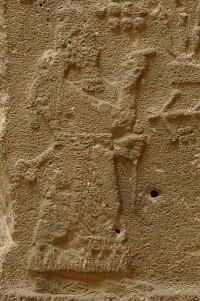The Tell al-Rimah Stela
Tell al-Rimah Stela (797 BCE): inscription by Assyrian king Adad-Nirari III, in which he describes his successes in the west.

In the first half of the ninth century BCE, the Assyrian kings Aššurnasirpal II (r.883-859) and Šalmaneser III (r. 858-824) had expanded the Assyrian Empire across the Euphrates to the Mediterranean Sea, adding what is now Syria. After that, there had been a crisis and the expansion had been interrupted, but Šalmaneser’s grandson Adad-Nirari III (r.811-783) resumed the western offensive.
Among the evidence are the Antakya Stela, the Nimrud Slab, and the Tell al-Rimah Stela (CoS 2.14F), which can be dated after 797 and was discovered in northern Iraq. The Tell al-Rimah inscription is interesting becaused it mentions tributes by king Jehoash of Israel and the kings of Tyre and Sidon.
The translation offered here is by K. Lawson Younger.
The Tell al-Rimah Stela
[1] To Adad, the greatest god, powerful noble of the gods, first-born son of Anu, unique, awesome, lofty, the canal-inspector of heaven and earth, who rains abundance, who dwells in Zamahu, the great lord, his lord.
[2] Adad-Nirari, mighty king, king of the universe, king of Assyria, son of Šamši-Adad, the king of the universe, king of Assyria, the son of Šalmaneser, the king of the four quarters.
[3] I mustered my chariots, troops, and camps; I ordered them, to march to the land of Hatti. In a single year, I subdued the entire land of Amurru and Hatti. I imposed upon them tax and tribute forever.
[4] I received 2,000 talents of silver, 1,000 talents of copper, 2,000 talents of iron, 3,000 linen garments with multicolored trim - the tribute of Mari' - of the land of Damascus. I received the tribute of Jehoash the Samarian, of the Tyrian ruler and of the Sidonian ruler.
[5] I marched to the great sea in the west. I erected a statue of my lordship in the city of Arvad, which is in the midst of the sea. I climbed Mount Lebanon; and I cut down timbers: 100 mature cedars, material needed for my palace and temples.
[the text continues with remarks about the exploitation of land in Mesopotamia and a curse against those who damage the stela]